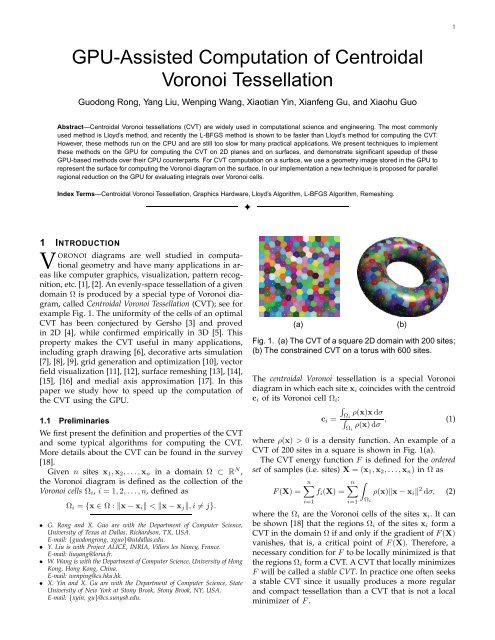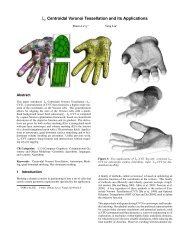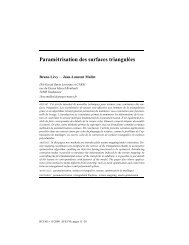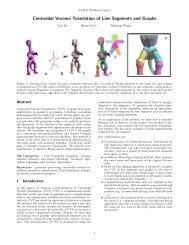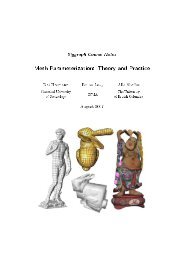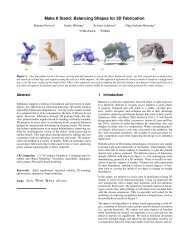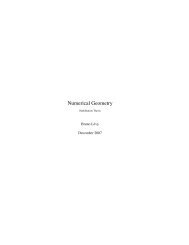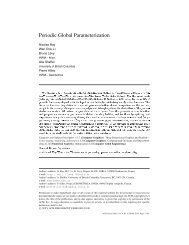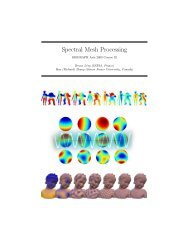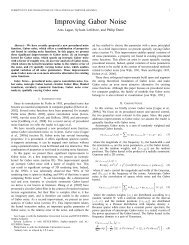GPU-Assisted Computation of Centroidal Voronoi ... - alice - Loria
GPU-Assisted Computation of Centroidal Voronoi ... - alice - Loria
GPU-Assisted Computation of Centroidal Voronoi ... - alice - Loria
You also want an ePaper? Increase the reach of your titles
YUMPU automatically turns print PDFs into web optimized ePapers that Google loves.
3parallel, similar to the flood-filling algorithm, but withfaster speed due to its use <strong>of</strong> varying step lengths. Wewill use the JFA to compute the <strong>Voronoi</strong> diagram in2D as well as on a surface. Like [19], [21] we use theEuclidean distance to approximate the geodesic distanceon a surface.To compute the <strong>Voronoi</strong> diagram on a surface, onemay compute a 3D <strong>Voronoi</strong> diagram and find its intersectionwith the surface. The <strong>GPU</strong> has also been usedto compute 3D <strong>Voronoi</strong> diagrams [27], [30], [31], [32],[33]. Weber et al. [34] adopted the raster scan methodin the geometry image to compute the <strong>Voronoi</strong> diagramusing the geodesic distance on a surface. This methodhandles disk-like open surfaces only. The geodesic distance,though more accurate than the Euclidean distance,is much less efficient to compute on a mesh surface, evenwith <strong>GPU</strong> acceleration.Vasconcelos et al.’s work [35] is the only known successfulattempt so far using the <strong>GPU</strong> to compute the CVTin a plane. They implemented the Lloyd’s method on the<strong>GPU</strong> to compute the CVT on a 2D plane, focusing on thecomputation <strong>of</strong> the centroids. A predefined mask is usedto conservatively estimate the <strong>Voronoi</strong> cell for every site.Since the diameter <strong>of</strong> a <strong>Voronoi</strong> cell may be very big, toensure an accurate result, the mask must be as big as thewhole texture, which makes the method inefficient.In contrast, we use the vertex program to performscattering and use the framebuffer blending function toaccumulate the coordinates. Our approach is simpler andworks well for computing both the CVT on a 2D planeand the CCVT on a surface.3 CVT ON 2D PLANEThere are two main steps in both Lloyd’s algorithmand the L-BFGS algorithm: 1) computing the <strong>Voronoi</strong>diagram <strong>of</strong> the current sites, and 2) finding new positions<strong>of</strong> the sites for the next iteration. For step 1, we computea discrete approximation <strong>of</strong> the <strong>Voronoi</strong> diagram usingthe jump flooding algorithm (JFA) [22] on the <strong>GPU</strong>. Wepropose a new regional reduction method for efficientlycomputing various integrals needed in step 2. In thefollowing we will briefly review the JFA and present theregional reduction technique.3.1 Jump Flooding AlgorithmSuppose that there is a site in an n × n texture in the<strong>GPU</strong> and we want to propagate some information (e.g.the coordinates <strong>of</strong> the site) from the site to all the otherpixels. The JFA performs this in several passes. For aninitial step length k that is a power <strong>of</strong> 2 (e.g. 2 ⌈log n⌉ ),a pixel at (x, y) passes its information to its neighbors(eight at most) at (x + i, y + j), where i, j ∈ {−k, 0, k}(Fig. 2). Then in the subsequent passes, the same propagationis performed for a pixel using the step lengththat is half <strong>of</strong> the previous step length k. The iteration isstopped when the step length reaches 1. Fig. 2 illustratesk=4 k=2 k=1Fig. 2. The iterations <strong>of</strong> the JFA for an 8×8 texture withan initial site at the bottom left corner.how the JFA fills up an 8×8 texture using three passeswith the single initial site at the bottom left corner.When using the JFA to compute the <strong>Voronoi</strong> diagramin a 2D texture, there are multiple sites and the informationto be propagated from each site is its coordinates.Upon receiving the coordinates <strong>of</strong> different sites, eachpixel compares its distances to these sites to find thenearest site whose <strong>Voronoi</strong> cell it belongs to. Thus allthe pixels are classified to form a <strong>Voronoi</strong> diagram.Despite its fast speed, the JFA may misclassify a smallnumber <strong>of</strong> pixels [22]. We use 1+JFA [33], an improvedversion <strong>of</strong> JFA, to compute the <strong>Voronoi</strong> diagram in our<strong>GPU</strong> implementations. On average, the error rate <strong>of</strong>1+JFA is less than 0.25 pixels in a texture with theresolution <strong>of</strong> 512×512 for less than 10,000 sites, which isaccurate enough for most practical graphics applicationsutilizing the CVT. To be brief, we will refer 1+JFA as JFAas well.A sufficiently large initial step length is needed toensure that each pixel is reached by its nearest site.On the other hand, one should try to use a small but“safe” initial step length to reduce the computation timeincurred by unnecessary JFA passes. A safe choice is2 ⌈log n⌉ , which is necessary for computing a <strong>Voronoi</strong>diagram when the sites are distributed in such a waythat each <strong>Voronoi</strong> cell is narrow and long, as the cellsgenerated by a sequence <strong>of</strong> collinear sites. However, thisinitial step length is, overall, very conservative becauseafter a few iterations <strong>of</strong> CVT computation (with eitherLloyd’s algorithm or the L-BFGS algorithm) the sites arenormally already distributed rather evenly, therefore amuch smaller initial step length would be sufficient foreach pixel to be reached by its nearest site.This consideration leads us to use the followingscheme for selecting the initial step length. In the VDcomputation <strong>of</strong> the first CVT iteration, the initial steplength <strong>of</strong> the JFA is set to be 2 ⌈log n⌉ . For the VDcomputation in the next m CVT iterations, we computethe average distance from each site to all the pixelsin its <strong>Voronoi</strong> cell using the regional reduction (to beintroduced in next subsection), and set the initial steplength <strong>of</strong> the JFA to be the double <strong>of</strong> the maximum<strong>of</strong> all these average distances. Our experiments showthat m = 5 gives satisfactory performance. Then in theremaining CVT iterations (i.e. after 5 iterations) the initialstep length <strong>of</strong> the JFA is set to be that used in the 5thiteration.
4VC0VC1C1part <strong>of</strong> <strong>Voronoi</strong> diagramx00x11x2 x3 x4 ...bottom left part <strong>of</strong> result textureFig. 3. Illustration <strong>of</strong> regional reduction. All the pointsin the <strong>Voronoi</strong> cell i (VC i ) are translated to the pixelcorresponding to the site x i .3.2 Regional ReductionSeveral different integrals over the <strong>Voronoi</strong> cells <strong>of</strong> allthe sites need to be evaluated in CVT computation,that is, for computing the value <strong>of</strong> the CVT energyfunction or computing the centroid as needed by theLloyd algorithm. To approximate these integrals, weneed to perform summations over the pixels <strong>of</strong> all the<strong>Voronoi</strong> cells in parallel, which calls for solving the socalledregional reduction problem.In the reduction problem, one needs to reduce a number<strong>of</strong> values to a single one, such as sum, maximum,minimum, etc. More precisely, the reduction problemtakes as input a set <strong>of</strong> values v 1 , . . . , v n and outputs asingle value v = v 1 ⊕ . . . ⊕ v n , where ⊕ is an associativeand commutative operator. Thus, summation is a specialcase <strong>of</strong> the reduction problem.The reduction problem can be solved in O(log n)passes on the <strong>GPU</strong> using a fragment program [36].Existing algorithms can only perform global reductions,that is, reducing values <strong>of</strong> all the pixels in a textureinto one single value. However, in CVT computationthe domain Ω is decomposed into multiple regions (thatis, <strong>Voronoi</strong> cells) Ω i and we need to compute the sums<strong>of</strong> values <strong>of</strong> the pixels <strong>of</strong> different regions in parallel.Therefore, we face a regional reduction problem ratherthan a global one.We propose to use the method <strong>of</strong> rendering pointsfor regional reduction. A single point is rendered forevery pixel, and its position is changed in the vertexprogram. All the points in the <strong>Voronoi</strong> cell <strong>of</strong> site x iare translated to the same position decided by its IDi. For example, the site x i corresponds to the position(i/w, i%w), where w is the width <strong>of</strong> the texture usedand “/” and “%” are division and modulus operators forintegers, respectively. The result is a texture containingthe reduction values for all the <strong>Voronoi</strong> cells, one pixelfor each site, which are packed in the order <strong>of</strong> the site’sID. Fig. 3 shows an illustration <strong>of</strong> this operation.First, every point is rasterized into one fragment.The fragment program processing these fragments thenwrites the values to a texture recording the results. Thedepth test or framebuffer blending operations can beused to reduce all the values corresponding to the samepixel to a single value which is stored in a result texture.For example, if we want to compute the maximum <strong>of</strong> thevalues, we can write the values into the depth channelas well as the color channels for every fragment, andset the depth test function so that only the fragmentwith the maximum value is stored into the result texture(e.g. using glDepthFunc(GL_GREATER)). If we wantto compute the sum <strong>of</strong> the values, we can write thevalues into color channels for every fragment, and set theblending function so that the values <strong>of</strong> all the fragmentsare added and the result is stored into the result texture(e.g. using glBlendFunc(GL_ONE, GL_ONE)).Our regional reduction method works for a connectedregion as well as a set consisting <strong>of</strong> disconnected regions.This is important because the <strong>Voronoi</strong> diagram <strong>of</strong> asurface may contain disconnected <strong>Voronoi</strong> cells nearthe boundaries <strong>of</strong> the geometry image (see Section 4).Furthermore, a <strong>Voronoi</strong> cell in a pixel plane may containdisconnected parts [37]; such a case can be handledproperly by our regional reduction method.3.3 Lloyd’s Algorithm in 2DEvery iteration in Lloyd’s algorithm contains two steps:1) computing the <strong>Voronoi</strong> diagram <strong>of</strong> the current sites;and 2) computing the centroids for <strong>Voronoi</strong> cells as thenew sites in the next iteration. These two steps areiterated until certain termination condition is met.On a 2D plane the centroids are computed using(1). Using regional reduction the integrations in (1) areapproximated by summations, so we have∑∑x∈Ωc i = iρ(x)x∆σ∑x∈Ω iρ(x)∆σ = x∈Ω iρ(x)x∑x∈Ω iρ(x) , (4)where the x is the pixel position and ∆σ the constantarea occupied by each pixel.The numerator and denominator in (4) are computedusing the regional reduction in the same pass since theyshare the same domain. The numerator is a 2D vectorstored in red and green channels <strong>of</strong> the texture, and thedenominator is a scalar value stored in the blue channel.We stress that the coordinates <strong>of</strong> each site <strong>of</strong> the<strong>Voronoi</strong> diagram are floating point numbers, albeit theyare stored in the discrete pixel closest to it. Since the<strong>Voronoi</strong> cells are composed <strong>of</strong> pixels, the <strong>Voronoi</strong> boundarieshave only pixel precision. The algorithm will stopwhen the <strong>Voronoi</strong> diagram does not change. Alternatively,a different termination condition can be used bychecking if the value <strong>of</strong> CVT energy function F or itsgradient has reached a threshold.3.4 L-BFGS Algorithm in 2DThe L-BFGS algorithm is a quasi-Newton algorithm thatis more efficient than Lloyd’s method for CVT computation[21]. In every iteration <strong>of</strong> the L-BFGS algorithm,we need to compute the CVT energy F and its partialderivatives with respect to all the sites. These valuesare accumulated with those values <strong>of</strong> the m precedingiterations to approximate the inverse Hessian matrix.
5SufaceParameter DomainInput Data Distortion Factor Initial Sites Initial <strong>Voronoi</strong> Diagram Final Sites Final CVDFig. 4. The pipeline for computing a CCVT on a surface. From left to right: the input David Head model together withits geometry image ((r,g,b)=(x,y,z)) and normal vector image ((r,g,b)=(n x , n y , n z )), distortion factors (modulated forvisual clarity), the initial sites and the corresponding <strong>Voronoi</strong> diagram, and the final sites with the CCVT. The top rowshows the parameter domain, and bottom row shows the surface.More specifically, define s k = X k − X k−1 and y k =∇F k − ∇F k−1 , where X k and ∇F k are the ordered set <strong>of</strong>sites and the gradient <strong>of</strong> the CVT energy function F atthe k-th iteration, respectively. Then the approximatedinverse Hessian matrix H k is updated byH k = V T k H k−1V k + ρ k s k s T k (5)where ρ k = 1/yk Ts k, and V k = I −ρ k y k s T k . The new sitesX k+1 for the next iteration is given by X k+1 = X k −H k ∇F k . More details <strong>of</strong> the L-BFGS algorithm are givenin [21].The first-order partial derivative <strong>of</strong> F with respect tothe site x i is [2]:∂F∂x i= 2∫Ω iρ(x)(x i − x)dσ. (6)This integral is approximated by summation in the <strong>GPU</strong>using the regional reduction, performed in the same passas computing the energy function F . These values arewritten into a texture and read back to the CPU, wherethey are used to compute the approximated inverseHessian matrix H k using (5) and then the new sitesX k+1 . Hence, our implementation <strong>of</strong> the L-BFGS methodis not entirely done on <strong>GPU</strong>.4 CCVT ON SURFACESIn this section we will explain the pipeline <strong>of</strong> computingthe CCVT on a surface, following the flow in Fig. 4.4.1 Geometry Image for Surface RepresentationFor a given surface we first compute a conformal parameterization[38] <strong>of</strong> the surface over a 2D rectangular domainand use the parameterization to construct a regularquad mesh to represent the surface. Then the surfacecan be represented by a 2D texture called the geometryimage [39] whose pixels store the 3D coordinates <strong>of</strong> the(a)Fig. 5. (a) A regular triangulation in a geometry image.(b) The corresponding triangulation on the surface.corresponding mesh vertices. The red, green and bluechannels <strong>of</strong> a geometry image store the 3D coordinates<strong>of</strong> the mesh vertices, respectively. The surface normalvectors at the vertices are also stored in a 2D texture <strong>of</strong>the same size, called normal vector image, which will beused in the L-BFGS algorithm for computing the CCVTon a surface.Due to parameterization distortion, each pixel is assigneda weight equal to the area it covers on thesurface. This weight is computed as follows. Supposethat the grid is subdivided to give a regular triangulationas shown in Fig. 5. Every pixel is supposed to coverone-third <strong>of</strong> each triangle incident to the correspondingvertex <strong>of</strong> the pixel. Thus the weight <strong>of</strong> the pixel is setto the 1/3 <strong>of</strong> the areas <strong>of</strong> all the triangles incident tothe corresponding vertex. The weight will be called thedistortion factor.The pipeline <strong>of</strong> computing the CCVT is shown inFig. 4. The left most part <strong>of</strong> Fig. 4 shows the geometryimage and the normal vector image <strong>of</strong> the surface <strong>of</strong>David Head in the top row, and the surface itself and acheckerboard texture showing the parameterization inthe bottom row. The computed distortion factors areshown in the left middle part <strong>of</strong> Fig. 4.Like the 2D case, computing the CCVT on a surface(b)
6implement Lloyd’s algorithm and the L-BFGS algorithmon the <strong>GPU</strong> to compute the CCVT on a surface.(a)Fig. 6. (a) The <strong>Voronoi</strong> diagram on a surface. (b) Thepartition <strong>of</strong> the geometry image induced by the <strong>Voronoi</strong>diagram in (a). The disconnected parts <strong>of</strong> a <strong>Voronoi</strong> regionare marked by ellipses in the geometry image.using either Lloyd’s algorithm or the L-BFGS algorithmtakes two main steps in each iteration: 1) computing the<strong>Voronoi</strong> diagram <strong>of</strong> the current sites on the surface, and2) computing the new sites for the next iteration. We willexplain these two steps in the following subsections.(b)4.2 Computing <strong>Voronoi</strong> Diagram on SurfacesSuppose that a given surface is represented as a geometryimage. We first store the 3D coordinates <strong>of</strong> the initialsites in the nearest corresponding pixels <strong>of</strong> the geometryimage, and then perform the JFA to compute a <strong>Voronoi</strong>diagram on the surface. Note that the Euclidean distancebetween points in 3D space is used as approximationto the geodesic distance when computing the <strong>Voronoi</strong>diagram on the surface.We use a single geometry image for parameterizing asurface <strong>of</strong> arbitrary topology, with necessary topologicalcutting to facilitate parameterization. Although only surfaceswith simple topology (open surface, cylinder andtorus) can be represented by a geometry image withoutsingularity. The singular points arising from a surface<strong>of</strong> complex topology do not pose any difficulty to our<strong>GPU</strong> programs. This is because the JFA only uses the3D coordinates in the <strong>Voronoi</strong> diagram computation,and does not use the texture coordinates, which are notunique for singular points.Due to topological cut, a <strong>Voronoi</strong> region on a surfacemay be split into disconnected regions in the geometryimage, as shown by the example in Fig. 6. Here, forexample, because the surface under consideration has acylinder topology, we need to identify the two oppositeboundaries <strong>of</strong> the geometry image when running the JFAto ensure that a correct <strong>Voronoi</strong> diagram is computedon the surface. Two disconnected parts in the geometryimage <strong>of</strong> a connected <strong>Voronoi</strong> region on the surfaceare marked by ellipses in Fig. 6(b). In this case wecompute the <strong>Voronoi</strong> diagram by identifying boundariesproduced by topological cut; the result for this exampleis shown in Fig. 6(a).Equipped with the above routine for computing the<strong>Voronoi</strong> diagram on a surface, we now explain how to4.3 Lloyd’s Algorithm on SurfacesUsing the geometry image to compute the CCVT on asurface with Lloyd’s algorithm follows the same procedureas for computing the CVT in 2D, except that weneed to compute the constrained centroids using (3).The following property about the constrained centroidwill be useful [19]: if c i and c ∗ i are the centroid and theconstrained centroid <strong>of</strong> the <strong>Voronoi</strong> cell Ω i respectively,then c i c ∗ i is parallel to the surface normal vector at c ∗ i .On the other hand, we observe that if c ′ i is the nearestpoint in Ω i to c i and it is not on the boundary <strong>of</strong> Ω i , thenc i c ′ i is parallel to the surface normal vector at c′ i . Basedon these observations we find it an effective heuristicto use the nearest point c ′ i as the constrained centroidc ∗ i in Lloyd’s algorithm, although they are not alwaysidentical, since c i c ′ i being parallel to the surface normalvector at c ′ i is not a sufficient condition for c′ i to be theconstrained centroid.The nearest point c ′ i is computed as follows. For thecorresponding mesh vertex <strong>of</strong> every pixel in Ω i , we computethe nearest point within its six incident trianglesto the centroid c i . To avoid redundant computations,we only need to check two incident triangles for everyvertex (e.g. the two shaded triangles in Fig. 5 for thecenter vertex), and the other four incident triangles willbe dealt by other neighboring vertices. In this way wefind a nearest point to the centroid c i for every pixel inΩ i . Then by computing the minimum <strong>of</strong> the distancesfrom these points to c i using the regional reduction, wefind the nearest point c ′ i within Ω i to c i .The number <strong>of</strong> iterations needed by both Lloyd’s andthe L-BFGS algorithms to obtain the CVT can be reducedsignificantly if the initial sites are roughly evenlydistributed on the surface. To obtain such initial sites,we use the distortion factors as a probability densityfunction to sample the initial sites in the geometry image.Therefore, a pixel with a larger distortion factor is morelikely to be selected as the initial site. The right middlepart <strong>of</strong> Fig. 4 shows 1,000 initial sites sampled accordingto the distortion factors and the <strong>Voronoi</strong> diagram generatedin the parameter domain (top row), as well as onthe surface (bottom row). The final sites and the CCVTare shown in the right most part <strong>of</strong> Fig. 4.4.4 L-BFGS Algorithm on SurfacesThe initial sites for the L-BFGS algorithm are also sampledaccording to distortion factors. In every iteration,to update the sites we need to evaluate the CVT energyfunction F and its partial derivatives. Because the sitesare constrained to be on the surface, we only use thetangential components <strong>of</strong> the partial derivatives as∂F∂x i∣ ∣∣∣Ω= ∂F∂x i−( ∂F∂x i· N(x i ))N(x i ), (7)
7(a) (b) (c)Fig. 7. The <strong>Voronoi</strong> diagram <strong>of</strong> 1,000 initial sites in the 2Ddomain <strong>of</strong> [−1, 1] × [−1, 1] (a), and CVT results generatedby the L-BFGS algorithm using (b) <strong>GPU</strong> and (c) CPU.(Unshaded cells are hexagons.)(a)(b)where N(x i ) is the surface normal vector at x i stored inthe normal vector image. Therefore we can use shadersto evaluate F and its partial derivatives on the <strong>GPU</strong>efficiently, in the same way as in the 2D case.The updated sites computed in the L-BFGS algorithmmay not lie exactly on the surface. We compute theirnearest points in their respective <strong>Voronoi</strong> cells on thesurface as the new sites on the surface.5 EXPERIMENTAL RESULTS AND DISCUSSIONWe implement our programs using Micros<strong>of</strong>t VisualC++.net 2005 and NVIDIA Cg 2.0. The hardware platformis Intel Core 2 Duo 2.93GHz with 2GB DDR2RAM, and NVIDIA GeForce GTX 280 with 1GB DDR3VRAM. For the L-BFGS algorithm, we use our HLBFGSlibrary [40]. We have compared our results with the CPUversion <strong>of</strong> Lloyd’s algorithm and the CPU version <strong>of</strong>the L-BFGS algorithm in [21]. We use m = 7 for allL-BFGS algorithms in our experiments; that is, we usethe gradients <strong>of</strong> the 7 previous iterations to estimate theinverse Hessian in our implementation.All the programs in this paper use IEEE standard floatpoint numbers (32-bit).5.1 Results <strong>of</strong> CVT in 2DThe first test example is the computation <strong>of</strong> the CVTin the 2D domain <strong>of</strong> [−1, 1] × [−1, 1] mapped to a512×512 texture, with 1,000 random initial sites. TheCVTs computed by the <strong>GPU</strong> program and CPU programare shown in Fig 7. It is clear that the uniformity <strong>of</strong>the sites is greatly improved in both results. We plotthe CVT energy values and their gradients versus thenumber <strong>of</strong> iterations for Lloyd’s algorithm and the L-BFGS algorithm in Fig. 8. The red and green curves arefor our <strong>GPU</strong> programs and the black and blue curvesfor CPU ones. For clarity, we show zoom-in views <strong>of</strong>the shaded regions in Fig. 8(b) and Fig. 8(d).The experiments show that the <strong>GPU</strong> result is veryclose to the CPU one, although there are fewer hexagoncells in the <strong>GPU</strong> result and the the final CVT energyvalue generated by the <strong>GPU</strong> is slightly higher. We may(c)Fig. 8. Energy values (a) and their gradients (c) <strong>of</strong> CPUand <strong>GPU</strong> programs for Lloyd’s algorithm and the L-BFGSalgorithm using 1,000 sites in the 2D domain <strong>of</strong> [−1, 1] ×[−1, 1]. (b) and (d) are zoom-in views <strong>of</strong> shaded regionsin (a) and (c).evaluate the quality <strong>of</strong> an approximate CVT by consideringits relative difference from CVT computed with theCPU, defined asCV T energy − final energy CPUfinal energy CPU(d)× 100%,where CV T energy is the CVT energy <strong>of</strong> the approximateCVT. For the tests shown in Fig. 8 the relativedifference is 0.69% for the result <strong>of</strong> Lloyd’s algorithmon <strong>GPU</strong> and 0.58% for that <strong>of</strong> the L-BFGS algorithm on<strong>GPU</strong>. These differences can be attributed to two factors.First, a different local minimum with higher energy isproduced by the <strong>GPU</strong> program. Second, the quantizationerrors in the <strong>GPU</strong> implementation are responsible.Table 1 compares the total running times <strong>of</strong> differentprograms for this example. The <strong>GPU</strong> program and CPUprogram <strong>of</strong> the same algorithm use the same number<strong>of</strong> iterations. Because <strong>of</strong> the line search used in the L-BFGS minimizer, the function evaluating gradients andenergy value may be called more than once in everyiteration. Within every function call, we need to rebuildthe <strong>Voronoi</strong> diagram and compute the gradients <strong>of</strong> theCVT energy, and this is the most time-consuming part <strong>of</strong>the L-BFGS algorithm and dominates the running time.For this reason, #Iter. for the L-BFGS method in Table 1is the number <strong>of</strong> the function calls.We see that the <strong>GPU</strong> program <strong>of</strong> Lloyd’s method isseveral time faster than the CPU program, because all thecomputations for Lloyd’s algorithm are executed on the<strong>GPU</strong>. However, the <strong>GPU</strong> program <strong>of</strong> the L-BFGS methodhas only about 30% speedup over its CPU counterpart.That is because, although the most time-consuming partsfor the L-BFGS algorithm are executed on the <strong>GPU</strong>, some<strong>of</strong> its computations are done on the CPU which takesabout 23% <strong>of</strong> the total time and is not accelerated by the
8TABLE 1Comparison <strong>of</strong> energy F and running time (in seconds)<strong>of</strong> different programs using 1,000 initial sites in the 2Ddomain <strong>of</strong> [−1, 1] × [−1, 1].TABLE 2Comparison <strong>of</strong> energy F and running time (in seconds)<strong>of</strong> different programs using 1,000 initial sites in the 2Ddomain <strong>of</strong> [−1, 1] × [−1, 1] with non-constant densities.Program#Iter.<strong>GPU</strong>CPUF Time F TimeProgram#Iter.<strong>GPU</strong>CPUF Time F TimeLloyd 216 2.628×10 3 0.550 2.610×10 3 1.535L-BFGS 92 2.612×10 3 0.512 2.597×10 3 0.703Lloyd 627 6.524×10 −5 2.529 6.163×10 −5 28.530L-BFGS 376 6.185×10 −5 2.301 6.116×10 −5 16.889TABLE 3Information <strong>of</strong> the five models used in this paper. Thelast two columns are for the number <strong>of</strong> boundaries andthe resolution <strong>of</strong> geometry images.Model #Vertices #Faces Genus #B GI(a)Fig. 9. CVT results <strong>of</strong> 1,000 initial sites generated bythe L-BFGS algorithm in the 2D domain <strong>of</strong> [−1, 1] ×[−1, 1] with the density function ρ(x) = e −20x2 −20y 2 +0.05 sin 2 (πx)sin 2 (πy) using (a) <strong>GPU</strong> and (b) CPU.<strong>GPU</strong>; and the communication between the CPU and the<strong>GPU</strong> also takes about 5% <strong>of</strong> the total time.We have also compared our <strong>GPU</strong> program <strong>of</strong> Lloyd’smethod to the algorithm proposed by Vasconcelos etal. [35]. For 1,000 sites, even with a very small mask(32×32), their program needs 1.416 seconds for the samenumber <strong>of</strong> iterations as in Table 1. If the size <strong>of</strong> themask is set to be same as the screen resolution (512),the running time becomes 44.521 seconds.Our <strong>GPU</strong> programs can also compute the CVT witha non-constant density function, as the density can besampled and stored as floating point numbers in atexture. An example is shown in Fig 9, comparing theCVTs computed by the <strong>GPU</strong> program and the CPUprogram <strong>of</strong> the L-BFGS method. The final CVT energyvalues and the total running time are listed in Table 2.5.2 Results <strong>of</strong> CCVT on SurfacesWe will compare our <strong>GPU</strong> programs and CPU programs<strong>of</strong> Lloyd’s algorithm and the L-BFGS algorithm usingfive surface models: Torus (Fig. 1), Lion (Fig. 10), Sculpture(Fig. 11), Body (Fig. 6), and David Head (Fig. 4).Table 3 lists information about these five models. All<strong>of</strong> our experiments use 1,000 initial sites on the surfacesampled according to distortion factors. For each model,the same set <strong>of</strong> initial sites are used as input for allprograms. The CPU programs utilize the fast algorithmintroduced in [41] which can greatly accelerate the computation<strong>of</strong> the intersection between the surface andthe 3D <strong>Voronoi</strong> diagram. For every model the geometryimage is pre-computed with user interaction in less than(b)Torus 4,096 7,938 1 0 512×512Lion 5,321 10,200 0 0 512×190Sculpture 5,471 10,364 3 0 512×372Body 13,978 27,295 0 2 512×456David Head 51,038 101,144 0 1 512×41610 seconds. This time is not included in the total runningtime reported below.The final energy values F and the total running time<strong>of</strong> the entire iteration procedure are listed in Table 4 andTable 5. Like the 2D cases, for the L-BFGS algorithm,the number <strong>of</strong> the function calls for VD computation islisted, rather than the number <strong>of</strong> iterations. The <strong>GPU</strong>program and the CPU program have the same number<strong>of</strong> iterations for Lloyd’s algorithm or the same number<strong>of</strong> function calls for the L-BFGS algorithm.It is observed that the <strong>GPU</strong> programs perform aboutone order <strong>of</strong> magnitude faster than their CPU counterparts.This speedup is more than that <strong>of</strong> the 2D casebecause the CPU programs for computing the CCVT <strong>of</strong> asurface need to compute a 3D <strong>Voronoi</strong> diagram and findits intersection with the surface, which is a very timeconsuming task compared with computing a <strong>Voronoi</strong>diagram in a 2D domain. Although the <strong>GPU</strong> programsalso compute distances in 3D, the whole algorithms arestill efficiently performed in a 2D domain.The relative differences between the <strong>GPU</strong> and CPUresults range from 0.88% to 8.36% due to differentdistortions <strong>of</strong> surface parameterizations. Fig. 10 andFig. 11 show two sets <strong>of</strong> results with the largest relativedifferences <strong>of</strong> Lion (genus 0) and Sculpture (genus3): the <strong>Voronoi</strong> diagram <strong>of</strong> the initial sites, and theCCVTs generated using the <strong>GPU</strong> and the CPU <strong>of</strong> Lloyd’salgorithm and the L-BFGS algorithm, with the samenumber <strong>of</strong> iterations for each algorithm. We note that the<strong>GPU</strong> results have larger energy values than their CPUcounterparts due its approximation nature.In addition to the comparison in terms <strong>of</strong> visualinspection and energy values, we may also measure thegeometric uniformity <strong>of</strong> the sites and their <strong>Voronoi</strong> cells
9(a) (b) (c) (d) (e)Fig. 10. Comparison <strong>of</strong> (a) the <strong>Voronoi</strong> diagram <strong>of</strong> initial sites and (b-e) the CCVT results on the surface <strong>of</strong> Lion.Results in (b-e) are generated by Lloyd’s (<strong>GPU</strong>), L-BFGS (<strong>GPU</strong>), Lloyd’s (CPU) and L-BFGS (CPU) algorithms,respectively. The relative difference is 5.07% for Lloyd’s algorithm ((b) and (d)) and 6.17% for the L-BFGS algorithm((c) and (e)). As a reference, the CVT energy <strong>of</strong> the initial sites is 2.538 ×10 −2 , and the relative difference between theinitial sites and the CPU results are 82.85% for Lloyd’s algorithm and 83.12% for the L-BFGS algorithm.(a) (b) (c) (d) (e)Fig. 11. Comparison <strong>of</strong> (a) the <strong>Voronoi</strong> diagram <strong>of</strong> initial sites and (b-e) the CCVT results on the surface <strong>of</strong> Sculpture.The results in (b-e) are generated by Lloyd’s (<strong>GPU</strong>), L-BFGS (<strong>GPU</strong>), Lloyd’s (CPU) and L-BFGS (CPU) algorithms,respectively. The relative difference is 7.88% for Lloyd’s algorithm ((b) and (d)) and 8.36% for the L-BFGS algorithm((c) and (e)). As a comparison, the CVT energy <strong>of</strong> the initial sites is 8.726 × 10 −3 , and the relative difference betweenthe initial sites and the CPU results are 91.02% for Lloyd’s algorithm and 90.44% for the L-BFGS algorithm.TABLE 4Comparison <strong>of</strong> energy F and running time (in seconds)<strong>of</strong> <strong>GPU</strong> and CPU programs for Lloyd’s algorithm.TABLE 5Comparison <strong>of</strong> energy F and running time (in seconds)<strong>of</strong> <strong>GPU</strong> and CPU programs for the L-BFGS algorithm.Model#Iter.<strong>GPU</strong>CPUF Time F TimeModel#Iter.<strong>GPU</strong>CPUF Time F TimeTorus 500 6.381×10 −4 8.235 6.304×10 −4 81.594Lion 135 1.458×10 −2 0.918 1.388×10 −2 20.25Sculpture 183 4.928×10 −3 2.229 4.568×10 −3 27.86Body 262 1.801×10 −4 3.760 1.776×10 −4 52.985David Head 215 9.998×10 −4 2.937 9.839×10 −4 144.688Torus 47 6.362×10 −4 0.808 6.307×10 −4 7.531Lion 28 1.472×10 −2 0.207 1.386×10 −2 3.500Sculpture 26 4.965×10 −3 0.331 4.582×10 −3 3.329Body 67 1.790×10 −4 1.004 1.774×10 −4 13.703David Head 33 1.010×10 −3 0.456 9.854×10 −4 15.609in the CCVT results. For every site x i , we define theradius r i <strong>of</strong> its <strong>Voronoi</strong> cell Ω i , the distance d i to itsnearest neighboring site, and the area a i <strong>of</strong> its <strong>Voronoi</strong>cell Ω i as follows:r i = maxx∈Ω i||x − x i ||, d i = minj≠i ||x i − x j ||, a i = Area(Ω i ).The standard deviations <strong>of</strong> r i , d i , and a i are used tomeasure the uniformity <strong>of</strong> a set <strong>of</strong> sites. Table 6 lists thestandard deviations for initial sites and the sites in theCCVT results on Lion. The uniformity <strong>of</strong> the initial sitesis greatly improved in all the results. Again, the <strong>GPU</strong>results are overall still not as good as the CPU ones.
10TABLE 6Comparison <strong>of</strong> the uniformity <strong>of</strong> 1,000 initial sites and thesites in CCVT results generated by different programs onthe surface <strong>of</strong> Lion.Program STDEV(r i ) STDEV(d i ) STDEV(a i )Initial Sites 1.450×10 −2 1.809×10 −2 3.717×10 −3Lloyd - <strong>GPU</strong> 7.422×10 −3 9.246×10 −3 1.902×10 −3Lloyd - CPU 3.228×10 −3 6.090×10 −3 1.002×10 −3L-BFGS - <strong>GPU</strong> 6.992×10 −3 9.657×10 −3 1.805×10 −3L-BFGS - CPU 2.868×10 −3 5.824×10 −3 9.046×10 −4(a)(b)The quality <strong>of</strong> the CCVT we computed with the <strong>GPU</strong>is heavily affected by the distortion factors. If the distortionfactors are very large in a certain part <strong>of</strong> a surface,the <strong>Voronoi</strong> cells in this part are mapped to a very smallregion in the geometry image. Then the resolution <strong>of</strong>the geometry image will not be adequate for accuratecomputation in this part <strong>of</strong> the surface, resulting in largererrors in the computation <strong>of</strong> centroids (for Lloyd’s algorithm)or energy value and gradients (for the L-BFGSalgorithm). To illustrate this, we compare the resultson David Head using two different parameterizations(see Fig. 12). Clearly, the second parameterization haslarger distortion, which leads to more artifacts than thefirst parameterization. This problem could be alleviatedby using a geometry image <strong>of</strong> higher resolution (seethe example in Fig. 12(e) and (h)), or using multiplegeometry images based a multi-chart surface parameterization[42].The CCVT can be used for surface remeshing bycomputing a well-shaped triangulation <strong>of</strong> the surface asthe dual mesh <strong>of</strong> a CCVT. Fig. 13 shows an example <strong>of</strong>remeshing the Body surface with 1,000 sites.(c) (d) (e)(f) (g) (h)Fig. 12. (a)&(b) Comparison <strong>of</strong> two different parameterizations<strong>of</strong> David Head. (c) the CVTs computed using theparameterization in (a) with a 512×416 geometry image;(d) the CVTs computed using the parameterization in (b)with a 512×191 geometry image; and (e) the CVTs computedusing the parameterization in (b) with a 2048×765geometry image. (f)-(h) are enlarged top views <strong>of</strong> thecircled part.5.3 JFA ErrorsIdeally, the CVT energy should decrease monotonicallyduring the iterations in both Lloyd’s and the L-BFGSalgorithm, if implemented accurately. However, sincesome pixels may be misclassified by the JFA into other<strong>Voronoi</strong> cells, the partial CVT energy values computedfor those <strong>Voronoi</strong> cells are slightly different to the accuratevalues. Despite this, the sites move greatly and thetotal CVT energy keeps decreasing in early iterations.However, in late iterations, when most <strong>of</strong> sites are nolonger moving, the error <strong>of</strong> JFA may cause the CVTenergy to fluctuate. When this happens, most sites wouldremain unchanged but a small number <strong>of</strong> sites mayoscillate between some positions.To evaluate the consequence <strong>of</strong> this oscillation, wecompared the JFA with an implementation on the <strong>GPU</strong>which computes the distance from every pixel to everysite accurately by brute force, and show the results inFig. 14. We see that the energy values only begins tooscillate in very late iterations due to the errors <strong>of</strong> theJFA.(a)Fig. 13. (a) The dual triangle mesh <strong>of</strong> 1,000 initial sites;and (b) dual triangle mesh <strong>of</strong> 1,000 final sites <strong>of</strong> the CCVT.The insets show the corresponding <strong>Voronoi</strong> diagrams onthe surface.(b)
11TABLE 8Comparison <strong>of</strong> Cg and CUDA running time (in seconds)<strong>of</strong> the L-BFGS algorithm for 1,000 sites in the 2D domain<strong>of</strong> [−1, 1] × [−1, 1]. All steps are executed 92 times.(a)Fig. 14. Energy values <strong>of</strong> Lloyd’s algorithm using the JFAand an accurate method to compute the <strong>Voronoi</strong> diagram<strong>of</strong> 1,000 sites on Sculpture. (b) A zoom-in view <strong>of</strong> energyplots in the shaded region in (a).TABLE 7Comparison <strong>of</strong> Cg and CUDA running time (in seconds)<strong>of</strong> Lloyd’s algorithm for 1,000 sites in the 2D domain <strong>of</strong>[−1, 1] × [−1, 1]. All steps are executed 243 times.(b)Step Cg Time CUDA TimeJFA 0.637 0.775Compute Centroids 0.237 0.413Test Stop Condition 0.015 0.107Draw New Sites 0.041 0.032Total Time 0.931 1.327In practice, this oscillation is very small and so doesnot affect the quality <strong>of</strong> the CVT for most applications ingraphics. One may handle this nonconvergent behaviorby terminating the computation when the CVT energyis found to increase.5.4 Shader Language VS. CUDACUDA is a relatively new and popular C-like languagefor general purpose computation on the <strong>GPU</strong>. SinceCUDA has some features not available in traditionalshader languages (such as accessing the shared memory),it is much faster for applications which can benefitfrom the new features. However, Cg is better suited thanCUDA for implementing CVT algorithms. To compareCg and CUDA programs, we list detailed time breakdownfor each step in Lloyd’s algorithm and the L-BFGSalgorithm for a 2D case in Table 7 and Table 8 (the timeis the total time for all iterations). It is clear that theJFA and the regional reduction (computing centroid forLloyd’s algorithm, and computing CVT energy and itsgradient for the L-BFGS algorithm) are the two stepsdominating the total running time. The Cg version isfaster for both steps than the CUDA version. In total,the CUDA versions are more than 40% slower than theCg versions.The better efficiency <strong>of</strong> the Cg implementation can beexplained as follows. The JFA spends most <strong>of</strong> its time onaccessing memory rather than computation. For everypixel, it needs to read information from nine pixels andwrite to one pixel (itself). The read addresses required bythe JFA are non-coalesced [43] and change in every passStep Cg Time CUDA TimeDraw Sites 0.046 0.057JFA 0.259 0.291Compute F and ∇F 0.117 0.261Total <strong>GPU</strong> Time 0.443 0.664Total Time 0.582 0.867according to different step lengths. So it is very difficult,if not impossible, to make this step efficient with CUDA.Computing the centroids in Lloyd’s algorithm (as wellas the energy value and gradients computation in theL-BFGS algorithm) is essentially a regional reductionproblem. The regional reduction is known to be difficultfor CUDA, since it requires many threads writing toa same memory address. This is usually implementedusing atomic operations [43]. Currently, CUDA only supportsatomic operations on integers. So for floating pointnumbers, we have to mimic the atomic operations bytagging the five least significant bits <strong>of</strong> the thread ID (see[44], [45] for details). This is inefficient and hardwaredependent,since the warp size must be known in advance.In conclusion, our algorithms for computing the CVTfit the traditional shader languages better than CUDAat this moment. However, as CUDA is fast evolving, webelieve that efficient atomic operations on floating pointnumbers will be available soon. That will be likely tomake CUDA faster than Cg for implementing our <strong>GPU</strong>algorithms in the near future.6 CONCLUSION AND FUTURE WORKWe have presented new techniques that use the <strong>GPU</strong>to compute the centroidal <strong>Voronoi</strong> tessellation both in2D and on a surface. We proposed a novel algorithmto directly compute the <strong>Voronoi</strong> diagram on a surface,and also presented a new method using the vertexprogram to perform the regional reduction. Equippedwith these two tools, we implemented two algorithms onthe <strong>GPU</strong> – Lloyd’s algorithm and the L-BFGS algorithm.For Lloyd’s algorithm, the entire procedure is performedon the <strong>GPU</strong>; and for the L-BFGS algorithm, the majorcomputational work is performed on the <strong>GPU</strong>. Our <strong>GPU</strong>implementations <strong>of</strong> the two methods have shown significantspeedup over their CPU counterparts. Althoughour results are discrete approximations to the true CVTs,we believe that many applications can benefit from thefast computation <strong>of</strong> the CVT made possible by our <strong>GPU</strong>basedalgorithms.In our current implementation <strong>of</strong> the L-BFGS algorithm,only the computation <strong>of</strong> CVT energy values andgradients, which is the most time-consuming part, is
13Proceedings <strong>of</strong> the Symposium on Interactive 3D Graphics and Games.ACM Press, 2008, pp. 89–97.[38] X. Gu and S.-T. Yau, “Global conformal surface parameterization,”in Proceedings <strong>of</strong> the 2003 Eurographics/ACM SIGGRAPH symposiumon Geometry processing. Aire-la-Ville, Switzerland, Switzerland:Eurographics Association, 2003, pp. 127–137.[39] X. Gu, S. J. Gortler, and H. Hoppe, “Geometry images,” ACMTransactions on Graphics, vol. 21, no. 3, pp. 355–361, 2002.[40] Y. Liu, “HLBFGS,” 2009, http://www.loria.fr/ ∼ liuyang/s<strong>of</strong>tware/HLBFGS/.[41] D.-M. Yan, B. Lévy, Y. Liu, F. Sun, and W. Wang, “Isotropicremeshing with fast and exact computation <strong>of</strong> restricted voronoidiagram,” Computer Graphics Forum, vol. 28, no. 5, pp. 1445–1454,2009, (Proceedings <strong>of</strong> Symposium on Geometry Processing 2009).[42] P. Alliez, M. Meyer, and M. Desbrun, “Interactive geometryremeshing,” ACM Transactions on Graphics, vol. 21, no. 3, pp. 347–354, 2002.[43] NVIDIA Corporation, “NVIDIA CUDA TM programming guide,”http://www.nvidia.com/object/cuda home.html, July 2009.[44] V. Podlozhnyuk, “Histogram calculation in CUDA,” NVIDIACorporation, White Paper, 2007.[45] R. Shams and R. A. Kennedy, “Efficient histogram algorithms forNVIDIA CUDA compatible devices,” in Proceedings <strong>of</strong> InternationalConference on Signal Processing and Communications Systems (IC-SPCS), 2007, pp. 418–422.


